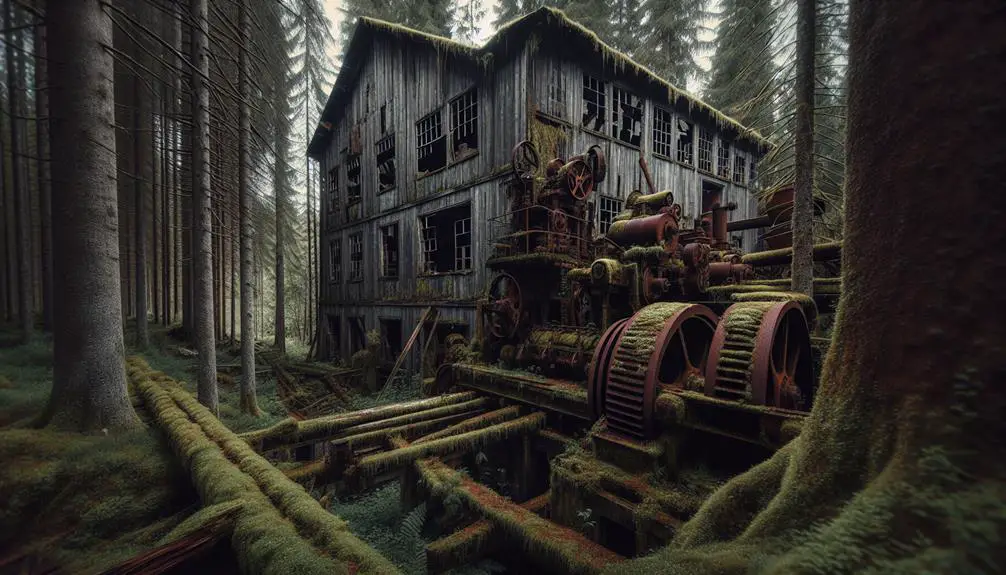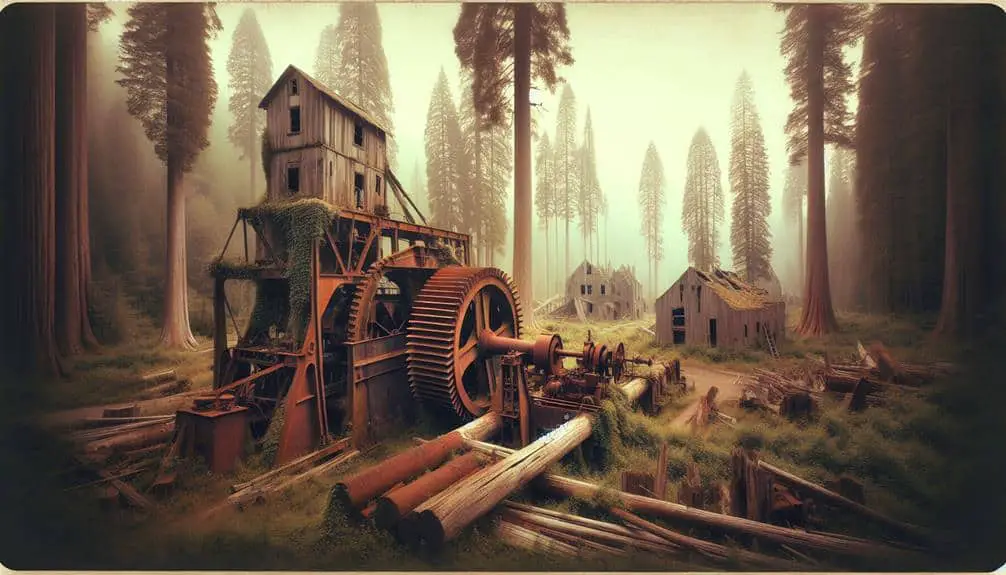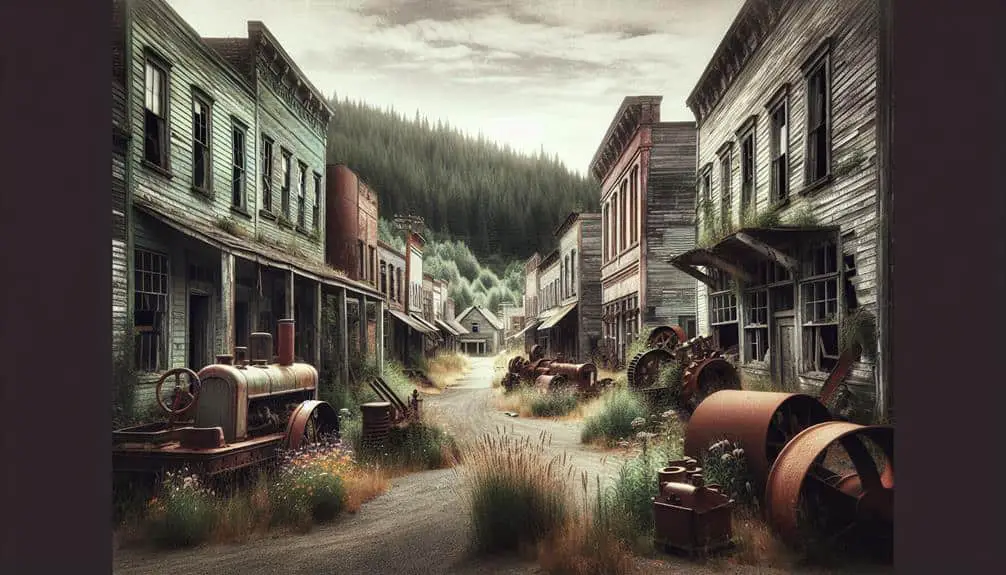When desolated woodcutting communities face waning industries, economic decline, environmental distress, social upheaval, and technological shifts converge. The dwindling logging industry sparks soaring unemployment, leading to mill closures and affecting local businesses. Deforestation disrupts ecosystems, diminishes biodiversity, and alters weather patterns. Gentrification, job losses, and social fragmentation erode community ties. Advanced machinery displaces labor forces, altering traditional practices. However, revitalization efforts through economic diversification, community engagement, and preservation initiatives offer hope to transform these ghost towns into thriving urban centers. A complex interplay of factors shapes the fate of these desolated communities.
Key Points
- Economic downturn from logging industry decline
- Displacement due to job losses and economic instability
- Fragmentation of community fabric and social bonds
- Gentrification leading to rising property prices
- Loss of cultural identity and social cohesion
Economic Impact of Declining Logging Industry
The dwindling logging industry's economic impact on these once vibrant communities has been devastating, leaving behind a trail of unemployment and financial hardship. As the primary source of employment and income, the decline in logging operations has led to soaring unemployment rates, forcing many residents to seek opportunities elsewhere. The closure of mills and logging companies hasn't only resulted in job losses but has also created a ripple effect on local businesses that relied on the industry for customers.
In the face of such economic turmoil, these communities are now faced with the urgent need for economic diversification. Local leaders and residents are exploring alternative industries such as tourism, agriculture, and technology to revive their once-thriving towns. However, shifting from a single-industry economy to a more diverse one is a challenging process that requires careful planning and investment.
Despite the hardships brought about by the decline of the logging industry, there remains a glimmer of hope as these communities work towards rebuilding their economies and creating a brighter future for generations to come.
Environmental Consequences of Overexploitation
Ravaging deforestation in these woodcutting communities has triggered a cascade of environmental repercussions, reshaping the landscape and ecosystem irreversibly. The relentless pursuit of timber resources has led to extensive habitat loss for countless species that once thrived in these forests. With trees being indiscriminately felled, the delicate balance of the ecosystem has been disrupted, causing a domino effect on plant and animal populations. Deforestation not only diminishes biodiversity but also contributes to soil erosion, impacting the stability of the land and water quality in the region.
The consequences of overexploitation extend beyond the immediate vicinity of the woodcutting communities, affecting the broader environment and climate. The loss of trees reduces the capacity to absorb carbon dioxide, a greenhouse gas that contributes to global warming. Additionally, deforestation disrupts local weather patterns and can lead to more frequent and severe natural disasters like floods and landslides. The scars left by unsustainable logging practices serve as a stark reminder of the irreversible damage inflicted upon the natural world.
Social Displacement and Community Fragmentation
Triggered by the environmental havoc wreaked by overexploitation, the unsettling repercussions of social displacement and community fragmentation among woodcutting settlements reveal a haunting legacy of desolation and upheaval. As woodcutting communities diminish, the effects of gentrification start to seep in, altering the cultural fabric that once held these settlements together. Here's why social displacement and community fragmentation play an important role in the transformation of these once-thriving areas:
- Gentrification Effects: The influx of outsiders seeking to capitalize on the now-abandoned woodcutting resources can lead to rising property prices, displacing original residents and eroding the community's identity.
- Cultural Preservation: Efforts to salvage the heritage and traditions of these woodcutting communities become paramount in the face of rapid urbanization and modernization.
- Loss of Social Cohesion: With families and neighbors forced to relocate, the tight-knit social bonds that sustained these settlements weaken, contributing to a sense of isolation and disconnection.
- Economic Instability: The dismantling of woodcutting industries often leaves residents grappling with unemployment and financial uncertainty, further fragmenting the community.
Technological Advancements and Automation
Revealing the profound impact of technological advancements and automation on woodcutting communities necessitates a thorough examination of the intricate interplay between innovation and traditional practices. Historically, woodcutting communities relied heavily on manual labor, with generations passing down the art of harvesting timber. However, the advent of advanced machinery and automation has revolutionized the industry, leading to a significant shift in labor dynamics. Job displacement within these communities has become a pressing issue as machines can now perform tasks that were once done by skilled workers. The labor force, once bustling with individuals adept at woodcutting, now faces challenges adapting to a more automated environment.
Technological advancements have streamlined the woodcutting process, increasing efficiency but also reducing the need for human intervention. While automation has its benefits regarding productivity, it has drastically altered the traditional way of life in woodcutting communities. The once vibrant towns now grapple with the consequences of this technological revolution, as job opportunities dwindle and the labor force struggles to find its place in an increasingly automated industry.
Revitalization Efforts and Future Prospects
Efforts to revitalize desolated woodcutting communities and explore future prospects have become imperative in the wake of technological advancements and automation's impact on the industry. These communities, once vibrant hubs of activity, now stand as remnants of a bygone era. To breathe life back into them and secure a promising future, consider the following:
- Community Engagement: Encouraging locals to actively participate in decision-making processes can foster a sense of ownership and pride in revitalization efforts.
- Urban Development: Reimagining these communities as modern urban centers while preserving their historical essence can attract new residents and businesses.
- Preservation Initiatives: Protecting the natural surroundings and historical landmarks can enhance the community's appeal for tourists and investors.
- Economic Diversification: Introducing new industries and sustainable practices can create job opportunities and maintain long-term viability for these communities.
Frequently Asked Questions
What Are the Psychological Impacts on Individuals in Desolated Woodcutting Communities as They Witness Their Town Becoming a Ghost Town?
As you witness your woodcutting community turn into a ghost town, the mental health toll is immense. Isolation creeps in, but community support and resilience can be lifelines, helping you navigate the psychological impacts with strength and hope.
How Does the Decline of the Logging Industry in These Communities Affect Local Wildlife Populations?
As the logging industry wanes, local wildlife faces a shifting landscape. Wildlife conservation efforts struggle to combat habitat destruction. Populations fluctuate, disrupting ecological balance. Imagine a delicate symphony – disrupted by the absence of its key players.
What Role Does Government Intervention Play in Supporting Displaced Residents of Desolated Woodcutting Communities?
Government support is essential for community resilience in desolated woodcutting areas. Aid programs, job training, and infrastructure projects can help displaced residents rebuild their lives. Such interventions play a pivotal role in fostering hope and progress.
Are There Any Cultural Traditions or Practices That Are Lost or Preserved as a Result of the Decline in the Logging Industry?
Preserving cultural traditions in desolated woodcutting towns is a delicate dance. As the logging industry fades, adapt to new economic rhythms while honoring heritage. Communities resiliently navigate change, balancing tradition with environmental conservation efforts.
How Do Desolated Woodcutting Communities Cope With the Loss of Their Main Source of Income and Identity?
You cope with the loss of income and identity in desolated woodcutting communities by seeking community support for mental health. Embrace economic diversification and sustainability to rebuild a future beyond the fading industry roots.



